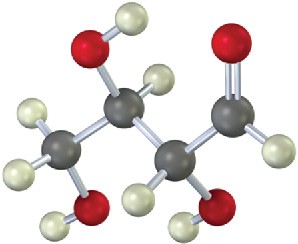25.2 Representing Carbohydrate Stereochemistry: Fischer Projections
Because most carbohydrates have numerous chirality centers, it was recognized long ago that a quick method for representing their stereochemistry was needed. In 1891, the German chemist Emil Fischer suggested a method based on the projection of a tetrahedral carbon atom onto a flat surface. These Fischer projections were soon adopted and are still a common means of representing stereochemistry at chirality centers in carbohydrate chemistry.
A tetrahedral carbon atom is represented in a Fischer projection by two crossed lines. The horizontal lines represent bonds coming out of the page, and the vertical lines represent bonds going into the page.
For example, (R)-glyceraldehyde, the simplest monosaccharide, can be drawn as in Figure 25.2.

Figure 25.2A Fischer projection of (R)-glyceraldehyde.
Because a given chiral molecule can be drawn in many ways, it’s sometimes necessary to compare two projections to see if they represent the same or different enantiomers. To test for identity, Fischer projections can be moved around on the paper, but only two kinds of motions are allowed; moving a Fischer projection in any other way inverts its meaning.
- A Fischer projection can be rotated on the page by 180°, but not by 90° or 270°. Only a 180° rotation maintains the Fischer convention by keeping the same substituent groups going into and coming out of the plane. In the following Fischer projection of (R)-glyceraldehyde, for instance, the –H and –OH groups come out of the plane both before and after a 180° rotation.

A 90° rotation breaks the Fischer convention by exchanging the groups that go into the plane with those that come out. In the following Fischer projections of (R)- glyceraldehyde, the –H and –OH groups originally come out of the plane but go into the plane after a 90° rotation. As a result, the rotated projection represents (S)- glyceraldehyde.

- A Fischer projection can also have one group held steady while the other three rotate in either a clockwise or a counterclockwise direction. The effect is simply to rotate around a single bond, which does not change the stereochemistry.

R,S stereochemical designations (Section 5.5) can be assigned to the chirality center in a Fischer projection by following three steps, as shown in Worked Example 25.1.
STEP 1
Rank the four substituents in the usual way (Section 5.5).
STEP 2
Place the group of lowest ranking, usually H, at the top of the Fischer projection by using one of the allowed motions. This means that the lowest-ranked group is oriented back, away from the viewer, as required for assigning configuration.
STEP 3
Determine the direction of rotation 1 → 2 → 3 of the remaining three groups, and assign R
or S configuration.
Carbohydrates with more than one chirality center are shown in Fischer projections by stacking the centers on top of one another, with the carbonyl carbon at or near the top. Glucose, for example, has four chirality centers stacked on top of one another in a Fischer projection. Such representations don’t, however, give an accurate picture of the molecule’s true three-dimensional conformation, which is curled around on itself like a bracelet.
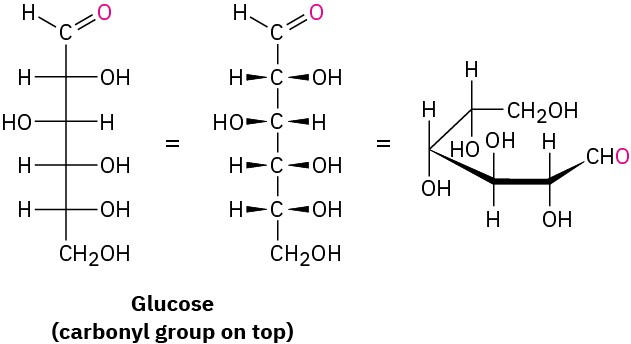
Worked Example 25.1Assigning R or S Configuration to a Fischer ProjectionAssign R or S configuration to the following Fischer projection of alanine:
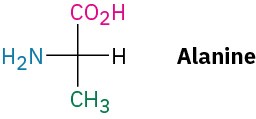 StrategyFollow the steps in the text. (1) Rank the four substituents on the chiral carbon. (2) Manipulate the Fischer projection to place the group of lowest ranking at the top by carrying out one of the allowed motions. (3) Determine the direction 1 → 2 → 3 of the remaining three groups.SolutionThe rankings of the groups are (1) –NH2, (2) –CO2H, (3) –CH3, and (4) –H. To bring the group of lowest ranking (–H) to the top, we might want to hold the –CH3 group steady while rotating the other three groups counterclockwise.
StrategyFollow the steps in the text. (1) Rank the four substituents on the chiral carbon. (2) Manipulate the Fischer projection to place the group of lowest ranking at the top by carrying out one of the allowed motions. (3) Determine the direction 1 → 2 → 3 of the remaining three groups.SolutionThe rankings of the groups are (1) –NH2, (2) –CO2H, (3) –CH3, and (4) –H. To bring the group of lowest ranking (–H) to the top, we might want to hold the –CH3 group steady while rotating the other three groups counterclockwise.
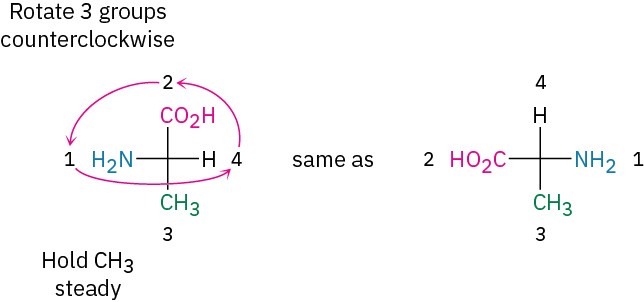
Going from first- to second- to third-highest ranking requires a counterclockwise turn, corresponding to S stereochemistry.

Problem 25-2
Convert each of the following Fischer projections into a tetrahedral representation, and assign R or S stereochemistry:
(a)
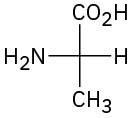
(b)
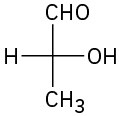
(c)
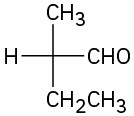
Problem 25-3
Which of the following Fischer projections of glyceraldehyde represent the same enantiomer?
(a) 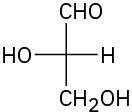 (b)
(b) 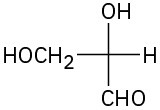 (c)
(c) 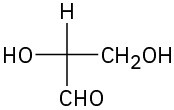 (d)
(d) 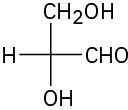
Problem 25-4
Redraw the following molecule as a Fischer projection, and assign R or S configuration to the chirality center (green = Cl):
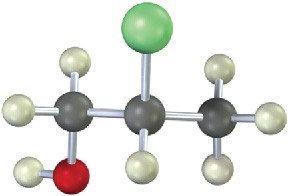
Problem 25-5
Redraw the following aldotetrose as a Fischer projection, and assign R or S configuration to each chirality center:
